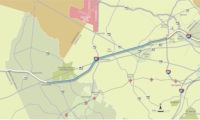"There was also an educational component to the design as the HOV lanes have been associated with a specific use for decades," Papiernik says. "Now being available to all drivers, we had to make signage and access points as clear as possible so that motorists can easily and safely make decisions as to whether to use the lanes at all and how far they want to travel on them."
To support this activity, the team used the VDOT-owned right-of-way along the route as material and equipment laydown space. That included areas under the I-95/395/495 "Mixing Bowl" flyovers near the Express Lanes' northern end and several interchange loop interiors.
"Once the HOV lanes closed for the night, we could shuttle materials to where they would be needed," Lewis says. "Sometimes, fill dirt had to be moved two or three times to get it to the right place."
The most complicated work took place at the median access ramp for the Springfield-Franconia Parkway overpass. It had to be widened by as much as 10 ft to safely accommodate new traffic flows while remaining available for HOV users. That meant sandwiching the existing retaining wall supporting the ramp with custom, mechanically stabilized earth (MSE) structures framed by post-tension strands attached to more than 310 steel piles.
More than 50,000 sq ft of MSE panels attached to the vertical posts provide an exterior finish for the structures, which rise as much as 35 ft from the median to the parkway.
Although the nine-mile-long greenfield construction area between the existing HOV southern terminus and State Route 610 in Stafford County was pinched on each side by I-95's general-purpose lanes, work proceeded virtually nonstop.
About 1 million cu yd of fill dirt and drainage upgrades were needed to shore up the Potomac clay formations in the median and grade foundations for the travel lanes, slip ramps and new 448-ft and 542-ft continuous-segment flyover structures that join I-95's southbound lanes. Five new bridges, ranging in length from 159 ft to 313 ft, were added as well.
Safety amid the scramble
The project team has focused as intently on safety as on the schedule. To ensure consistency through the project, all subcontractors were required to undergo Fluor-Lane's safety orientation training as well as their own programs. The team also worked with VDOT to develop one-way construction area entrances/exits to ease trucks safely in and out of mainline traffic.
Through nearly 3 million work hours, the project's incident rate is 0.48—well below the Occupational Safety and Health Administration national average of 3.6.










Post a comment to this article
Report Abusive Comment